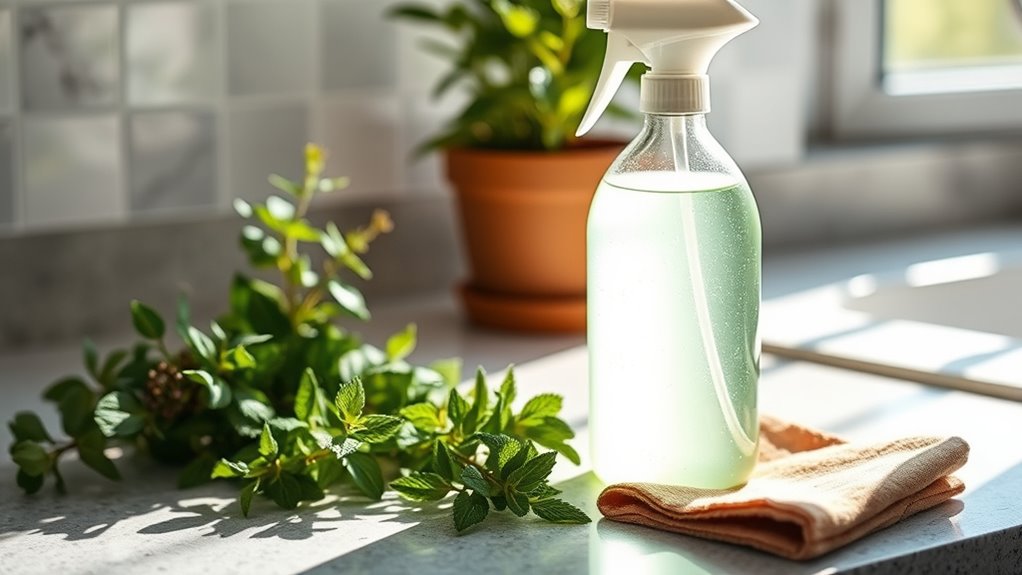While traditional bleach isn’t considered green due to its harmful chemicals and environmental impact, there are eco-friendly alternatives you can use for disinfection. Natural options like vinegar, baking soda, hydrogen peroxide, and plant-based disinfectants effectively kill germs without polluting waterways or causing health issues. These solutions are biodegradable, safer for your skin, and better for the planet. Want to discover more sustainable cleaning tips? Keep exploring for greener ways to disinfect your home.
Key Takeaways
- Traditional bleach contains harsh chemicals that harm the environment and human health, making it not eco-friendly.
- Natural disinfectants like vinegar, essential oils, and botanical solutions are effective eco-friendly alternatives.
- Plant-based disinfectants break down quickly, leaving no harmful residues in waterways or ecosystems.
- Properly used natural stain removers and disinfectants can match bleach in germ elimination without toxicity.
- Choosing biodegradable, plant-derived cleaning products supports sustainable and safer household disinfection practices.

Many traditional bleaches contain harsh chemicals that can harm your skin, pollute waterways, and damage the environment. That’s why exploring eco-friendly alternatives is more important than ever. Plant-based disinfectants are gaining popularity because they’re derived from natural ingredients like essential oils, vinegar, and other botanicals. These options are effective at killing germs without the toxic side effects associated with chlorine or bleach. When you choose plant-based disinfectants, you’re not only safeguarding your health but also reducing your ecological footprint. They often come in concentrated forms, so a little goes a long way, making them both economical and sustainable.
Switch to plant-based disinfectants to protect your health and the planet.
Natural stain removers are another eco-friendly solution that can replace traditional bleach in your laundry routine. Products made from natural enzymes, baking soda, or lemon juice work to lift stains without the harsh chemicals. For example, a mixture of baking soda and hydrogen peroxide can serve as a powerful, non-toxic stain remover. These natural options are gentle on fabrics and safe for your skin, unlike conventional bleaching agents that can cause irritation or damage. Plus, they don’t emit harmful fumes, making your laundry space safer and more pleasant. Incorporating eco-friendly cleaning practices can significantly reduce your household’s chemical load and environmental impact.
Switching to these alternatives doesn’t mean sacrificing effectiveness. Many plant-based disinfectants are designed to combat a wide range of bacteria and viruses, especially when used correctly. You’ll find that natural stain removers are equally good at tackling tough spots on clothes, upholstery, and even kitchen surfaces. The key is understanding how to use them properly and in appropriate concentrations. Incorporating natural products into your cleaning routine often involves simple, everyday ingredients you already have at home, like vinegar, lemon, or baking soda, which makes the switch straightforward and cost-effective.
Beyond their cleaning power, these eco-friendly options support a healthier environment. Unlike traditional bleach, which releases chlorinated compounds into waterways and contributes to pollution, plant-based disinfectants break down quickly and don’t leave harmful residues. This means you can disinfect your home with a clear conscience, knowing you’re not contributing to environmental degradation. Additionally, many natural stain removers are biodegradable, so they won’t linger in ecosystems or harm aquatic life.
Frequently Asked Questions
Can Natural Bleach Alternatives Kill Mold Effectively?
Natural bleach alternatives can kill mold effectively because they often involve chemical reactions that disrupt mold’s structure. Products like hydrogen peroxide or vinegar work by altering pH levels, making environments inhospitable for mold growth. You should guarantee proper application and contact time, as the success depends on these factors. While not as powerful as bleach, these eco-friendly options can be safe and effective for mold removal when used correctly.
Are Eco-Friendly Disinfectants Safe for Children and Pets?
Imagine a safer home environment—are eco-friendly disinfectants truly safe for your children and pets? These alternatives often minimize harmful chemicals, addressing household safety concerns and chemical sensitivities. While they’re generally gentler, it’s essential to read labels carefully and follow usage instructions. You can protect your loved ones without compromising cleanliness, but staying informed ensures you choose the safest options for your family’s health.
How Long Do Eco-Friendly Disinfectants Take to Kill Germs?
Eco-friendly disinfectants usually take about 1 to 10 minutes to effectively kill germs, depending on their chemical reactions and the contact time. You need to allow sufficient contact time for the disinfectant to work properly, as this guarantees the germs are destroyed. Always follow the product instructions carefully, and keep the surface wet for the recommended duration to maximize germ elimination and safety for your family and pets.
Do Plant-Based Bleaches Stain or Damage Fabrics?
Did you know that plant-based enzymes are gentle yet effective? When it comes to fabric staining or damage, plant-based bleaches are generally safer than traditional bleach. However, they can cause fabric color fading if not used properly. Always follow instructions, test on a small area first, and choose products formulated for your fabric type. This way, you protect your clothes while enjoying eco-friendly cleaning.
Are Eco-Friendly Disinfectants Cost-Effective Compared to Traditional Bleach?
You might wonder if eco-friendly disinfectants are cost-effective compared to traditional bleach. When considering cost comparison, eco-friendly options often have a higher upfront price but can be more economical over time due to their concentrated formulas and fewer health risks. Market availability has improved, making these alternatives easier to find at many stores. So, while initial costs may be higher, eco-friendly disinfectants can be a smart, sustainable choice.
Conclusion
While traditional bleach may not wear a green guise, exploring eco-friendly alternatives allows you to make more conscientious choices. By opting for plant-based disinfectants or natural solutions, you subtly embrace sustainability without sacrificing cleanliness. These gentle yet effective options offer a refined way to maintain hygiene, gently guiding your routine toward a more environmentally harmonious path. Ultimately, the mindful selection of such alternatives reflects a quiet elegance in caring for both your space and the planet.










